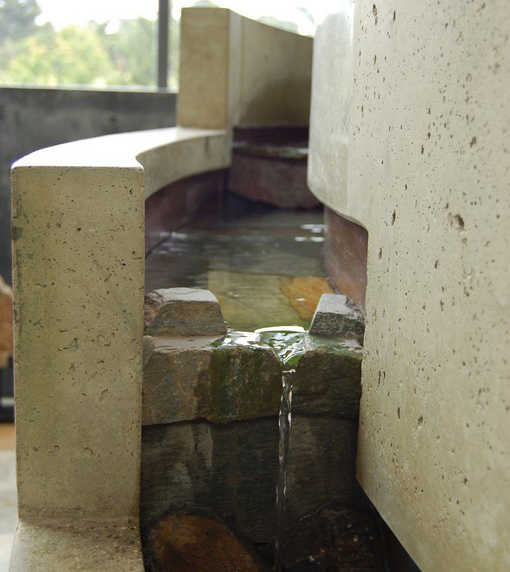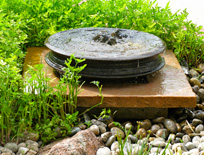waterfeatures
By Fu-Tung Cheng I’ve never been entirely comfortable with the term “decorative concrete.” To me, the pairing of the words has always implied that one merely applies material over a substrate in the way a baker might apply icing to decorate a cake. Instead, I see concrete as inherently profound. More than appliqué, it is a medium that has long been used functionally as well as expressively. In my own case, I feel far more creatively engaged in my work when I merge my thinking about those dual potentials of function and art. Historically, in fact, I believe that when the two become an inseparable one, we recognize and celebrate these works as rising to the level of great design. In my own case, I began using concrete as an expressive medium a few decades back, when I was among the pioneers in designing and installing concrete countertops in contemporary kitchens. As both designer and builder, by the year 2000 I had
Decorative-concrete artist Tommy T. Cook has built a reputation for being able to create almost anything from concrete using an array of highly refined and boldly artful processes. In this feature, he demonstrates a portion of that skill by describing how he uses the gargantuan Gunnera plant to craft watershapes in which replicas of the plant’s outsized leaves serve as uniquely natural fountain basins and spillways. Ask anyone who’s tried and it’s almost certain you’ll hear that replicating nature isn’t easy. That hasn’t stopped artists throughout history from trying, however, or from making natural forms an influential source of artistic imagination and ambition. The great thing about using nature for inspiration is that it’s all around us and all we need to do to draw on it is open our eyes, make good choices and decide how what we see can be used in our creative endeavors. In my case, I’d worked in decorative concrete for a long time before nature crawled under my skin. It began when
Among the most gratifying of all projects are those in which designers are able to forge links between different areas of a property, creating an unfolding, choreographed experience that generates notes of anticipation along with reassuring sensations of comfort and familiarity. In our work at Root Design Company (Austin, Texas), we’ve found that water is a powerful tool in defining those sorts of connections within a property, whether it is used in bold ways, as with fountains or swimming pools, or as subtler secondary or tertiary elements, including runnels or small waterspouts. In the project depicted here, we used multiple watershapes within architectural spaces that organize those settings and bring motion and continuity to the overall space. It all ties together visually, with each path leading to intriguing destinations that serve as rewarding visual experiences for anyone who visits. As we see it, the key ingredient in this project was our client, who understood
The warmth and solid heft of aged, cast brass are the hallmarks of the antique rice cooker — a treasure acquired in India several years ago — that now makes a statement to visitors approaching a modern Colorado home's front door. Forged more than 150 years ago using the same techniques employed in making
With watershapes, sometimes the most straightforward forms work out best. That was definitely the case with this project, a swimming pool I designed and built for a beach club near my home in Guanacaste, Costa Rica. The club is part of an overall resort property known as Reserva Conchal, an utterly spectacular spread covering 2,500 acres on scenic Playa Conchal on our country’s north Pacific coast. I first became involved with the resort’s owners about ten years ago, when they were completing their first phase and I helped them solve some problems with a pool that had been built by another firm. Since then, as the owners’ master plan has gradually unfolded, I’ve worked with them on a number of pools in various spots around the huge property, including watershapes for various condominiums and other facilities. My involvement with their newly constructed club has been, by far, the most
Everything about this project was classic and beautiful. For one thing, the home has the soft look of a French country chateau. For another, it’s located in Hancock Park, one of the oldest of Los Angeles’ upscale downtown neighborhoods. And when you add in the fact that it sits on a half-acre-plus lot on a quiet street, we had the pleasing sense that we’d landed on a refreshing oasis at the heart of a bustling metropolis. We also enjoyed the privilege of working here with Andres Cardenes, a wonderful architect who had collaborated with these clients on and off for several years. In their latest endeavor, he had come in to refurbish the home along historic and formal lines – something that often happens in this neighborhood, which boasts numerous restored and beautifully maintained homes across a range of architectural styles. Our firm, New Leaf Landscape of Agoura Hills, Calif., had worked with Cardenes on previous projects. When he called, he talked a bit about the situation and let us know that he thought we’d be a great fit because of the way we
Not long ago, I did a pair of columns on healing gardens and their benefits. If you’ll recall, I preached the importance of persuading hospitals in particular to include these spaces in their overall site plans as a means of providing garden environments for patients, patients’ families and hospital staff: These spaces reduce stress, help patients heal more quickly and give everyone who visits them a soothing sense of tranquility. I’ve attempted to the greatest extent possible to practice what I preached, and through the years I’ve installed numerous health-specific gardens at local assisted-living centers, Alzheimer’s care facilities and even at a center for emotionally-challenged children. But truth be told, I haven’t met with much success with our local hospitals, despite the fact that healing gardens have caught on with countless such facilities coast to coast. I don’t know quite why this is, but we
It was no easy task: We were called on to take the majestic landscape defined by the confluence of the Mississippi and Missouri rivers; use it as a template for an urban oasis filled with sculptures, plants and water; and develop a park that would mesh seamlessly with its surrounding urban spaces. Furthermore, they wanted this park to appeal to every conceivable user – people of all ages, needs and backgrounds – while also serving as a catalyst for growth and a profound revival of the city’s core. And not only was the space to carry that symbolic load, but it also had to function efficiently with long-term reliability. We at Hydro Dramatics (St. Louis, Mo.) know from experience that projects of this scope and scale require much planning and coordination to go along with large measures of innovation. We also know that these types of challenges make success that much sweeter. So we jumped into the task with all our energy, supporting the design team charged with developing Citygarden, a 2.9-acre parcel to be filled with
If you’ve ever spent time in the hospital, you’re probably like me in having done your best to forget the experience. Not only were you recovering from some sort of serious injury or illness (or visiting a loved one who was), but you also had to endure the process in an environment that wasn’t quite hospitable. Most likely the room you or your loved one occupied was filled by an adjustable bed surrounded by beeping instruments. The walls were putty-white and scuffed, a couple of cellblock-like doors led to the bathroom and hallway – and a worn-out television hung questionably above the bed, threatening to
In December 2004, WaterShapes introduced ‘The Platinum Standard,’ a registry of projects that embodies watershaping at its finest. Now, as part of our celebration of the magazine’s 100th Issue, Eric Herman offers ‘The Platinum Standard II,’ a fresh set of 20 projects that have graced the pages of the magazine in the past three-and-a-half years – projects that demonstrate clearly that watershaping has become an art form in its own right. I’ll never forget the day Jim McCloskey suggested starting a magazine on systems that contain and control water. We were walking near his home in Woodland Hills, Calif., when he broached the idea, saying it had come to him as something of an epiphany while





















